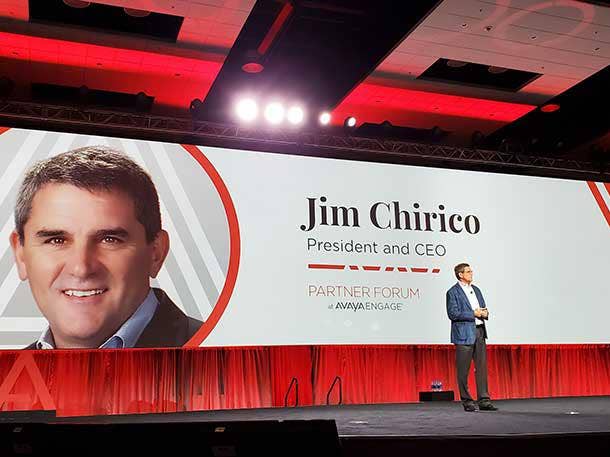Avaya CEO: Record-Smashing Services, Subscriptions Are ‘Proof’ That COVID-19 Has Sped Digital Transformation
After topping its own sales records for software, cloud and subscriptions in the third quarter, Avaya CEO Jim Chirico tells CRN that there‘s still plenty of runway for partners to sell Avaya’s portfolio to transformation-minded clients.

Unified communications powerhouse Avaya beat its own records around software, cloud and subscription sales as COVID-19 continues to pressure businesses to quickly transform their IT and communications strategies.
“We‘re now seeing a lot of proof points that indeed COVID-19 is accelerating our customers’ digital transformation by at least two to three years. These customers are continuing to put a lot of money on the table for work-from-home initiatives,” Avaya CEO Jim Chirico told CRN following the company’s third-quarter 2020 earnings call.
Avaya‘s software and services as a percentage of revenue was 89 percent during the company’s third fiscal quarter, topping the record of 88 percent set in March in second-quarter 2020. About 60 percent to 70 percent of that revenue was driven by partners, Chirico said. Recurring revenue also climbed 5 percent year over year to account for 64 percent of the company’s overall revenue.
[Related: Avaya OneCloud Rebrand Flexes Cloud, Subscription-Based Services Focus]
But perhaps the biggest change the company has seen as a result of the pandemic is the move to subscriptions, Chirico said. Avaya first introduced a subscription model in December and subscription revenue has been strong, with more than $200 million in total contract value having been booked since the launch. Avaya OneCloud subscription total contract value increased by about $130 million during the third quarter of 2020, Avaya said.
“[Subscriptions] are great for customers because it provides them the Opex model they need, repositions the number of licenses that they have, and for us, it‘s three-plus years of confirmed contracts and a vehicle for us to move new, innovative technologies in with these offerings,” he said. ”Our largest VARs are doing quite well with subscriptions.”
The U.S. dominated the subscription model in the second quarter but subscription revenue started to grow internationally during the third quarter, according to the company.
Chirico told CRN in May that Avaya‘s goal was to move about 25 percent of its existing maintenance-oriented, annual contracts to a subscription-based contract—a goal the company said it is on track to hit by the end of its last fiscal quarter of the year in September.
Santa Clara, Calif.-based Avaya last week rebranded its entire portfolio of contact center, unified communications, collaboration and Communications-Platform-as-a-Service (CPaaS) offerings under the Avaya OneCloud name. The rebrand will help partners, in particular, more easily sell Avaya‘s portfolio, Chirico said.
“We‘ve rebranded ourselves as a cloud company,” he said. ”It’s hard to go out and sell [Avaya] Spaces, Equinox, Oceana; all these names that mean nothing. By doing this rebranding effort, we are accelerating those revenues and adoption. This renaming will make it simpler for partners … because we are a portfolio company with a rich set of products.”
Avaya Cloud Office powered by RingCentral, which the company released in the U.S in March, launched in the third quarter in Australia, Canada and the U.K. and now includes enhanced automated migration tools. Despite many businesses already having deployed communications solutions to address the work-from-home requirements, Chirico believes there‘s still plenty of runway with this UC offering for partners. In addition, he sees opportunity for partners to build businesses around contact center and video. The company’s videoconferencing and collaboration platform, Avaya Spaces, saw about 550 percent growth in the third quarter.
Avaya‘s hardware business declined in third-quarter 2020 by 13.8 percent to $261 million compared with $297 million a year ago, but despite the dip, Chirico said that hardware isn’t dead. “The 2.5 million remote licenses we deployed were all on-prem, so it’s still extremely relevant, especially in the large enterprise that hasn’t converted to a public cloud yet,” he said.
Chirico said Avaya will be working with these customers through their digital transformation journeys to get them to private or public cloud-based offerings. “We‘re converting more than 50 percent of these into subscription-based revenue streams,” he added.
Trends like remote working and education played out in the third quarter compared with earlier in the year, signaling that they aren‘t budging anytime soon. “We’re seeing it all come together whereas last quarter we were wondering if this was the new normal,” Chirico said. ”We are seeing further opportunities for our technologies, especially software and services, which continue to be a bigger and bigger part of our revenue.”
For third-quarter 2020 ended June 30, Avaya Holdings’ overall revenue climbed slightly year over year to $722 million compared with $720 million in third-quarter 2019.